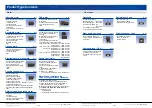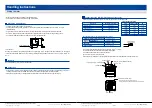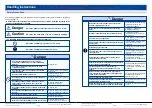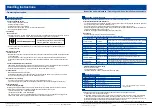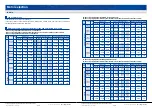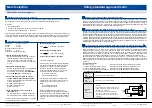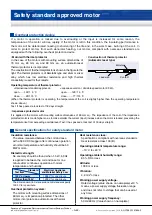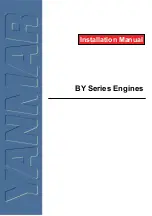
– A-50 –
Panasonic Corporation Electromechanical Control Business Division
industrial.panasonic.com/ac/e/
©
Panasonic Corporation 2018
AQCTB02E 201806-E
– A-51 –
Panasonic Corporation Electromechanical Control Business Division
industrial.panasonic.com/ac/e/
©
Panasonic Corporation 2018
AQCTB02E 201806-E
Checking of permissible inertia load
When the load inertia
J
connected to the gear head is large, frequent starting of the motor or electromagnetic
brake generates a large torque. If this impact is excessive, it may damage the gear head and the motor. Since
inertia varies with types of the load, the tables on pages A-54 and A-55 describe how to calculate inertia of
different shape loads. The inertia of the load significantly affects life expectancy of gear and electromagnetic
brake. When applying the braking force by using the electromagnetic brake or brake unit, do not exceed a
permissible load inertia set for a specific model.
The permissible load inertia to a 3-phase motor is the inertia applied to the motor after it stops and then starts in
the opposite direction.
• Find the load inertia to the motor
shaft from the following formula.
(SI units system)
J
M
= J
G
x
J
G
: Inertia of gear head output shaft
(kg·cm
2
)
J
M
: Permissible inertia at motor shaft
(kg·cm
2
)
i
: Reduction ratio (e.g. 5 if the ratio is 1/5)
*
The formula also applies to
GD
2
system.
Motor and load inertia
The equation of motion is described as below when the inertia load is driven by the motor.
where,
T
: Torque
(N·m)
J
: Moment of inertia
(kg·m
2
)
: Angular speed
(rad/s)
t
: Time
(s)
n
: Rotational speed
(r/s)
GD
2
: Flywheel effect
(GD
2
= 4J)
g : Gravitational acceleration = 9.8
(m/s
2
)
: Angular acceleration
(rad/s
2
)
In the case of induction motor, torque generated at the starting varies depending on the speed. Therefore, an
average acceleration torque is generally used, which is the averaged torque from the starting and the constant
speed.
A necessary average acceleration torque
T
A
to accelerate the load inertia of
J
(kg·cm
2
) (GD
2
(kgf·cm
2
))
up to a
speed
n (r/min)
in time
t (s)
can be obtained by the following formula.
• SI units
• Gravitational system of units
i
2
1
T = J = J · = · = · ·
T
A
=
x
(N·m)
T
A
=
x
(kgf·cm)
d
dt
d
dt
dn
dt
2π
60
GD
2
4
J
9.55
x
10
4
N
t
N
t
GD
2
3750000
GD
2
4
To describe the moment of inertia,
J
and
GD
2
is used.
J
is generally called inertia and has the same value of
physical moment of inertia in SI units. Unit is in
kg·m
2
.
GD
2
(GD square) is called “flywheel effect” and generally used in industrial application with gravitational systems
of units. Unit is in
kgf·m
2
or
kgf·cm
2
. A relation between
J
and
GD
2
is described as:
J = GD
2
/ 4
For the purpose of this document, both
J
for SI units and
GD
2
for gravitational system of units are used. Unit of
J
should be
kg·m
2
in dynamical significance, however,
kg·cm
2
is used as well for convenience. Refer to pages A-54
and A-55 for calculation of
J
and
GD
2
depending on the shape of the load.
• Find the permissible load inertia moment at gear
head output shaft from the following formula.
When reduction ratio is 1/3 to 1/50,
J
G
= J
M
x
i
2
When reduction ratio is 1/60 or larger,
J
G
= J
M
x
2500
J
G
: Permissible load inertia moment at gear head output
shaft
(kg·cm
2
)
J
M
: Permissible inertia at motor shaft
(kg·cm
2
)
i
: Reduction ratio (e.g. 5 if the ratio is 1/5)
Permissible inertia
(J
M
)
at motor shaft varies with motors.
To find the inertia for the motor in question, refer to tables
on pages A-52 and A-53.
Inertia
Motor selection




